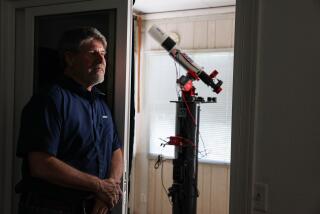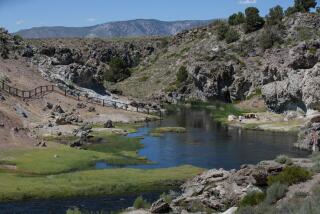Low Tolls Reassure Scientists on Volcano Predictions : Warnings: Experts now are able to issue credible forecasts days ahead of most eruptions, allowing thousands to flee to safety.
Two major volcanic eruptions in the Western Pacific in recent days have claimed only a few lives, reassuring scientists who have been desperately trying to improve their chances of predicting which volcanoes are about to blow their lids.
Although it is still impossible to predict down to the minute when any volcano is going to erupt, scientists are now able to issue credible warnings days ahead of most eruptions, thus allowing thousands to flee to safety.
Considering the rate of population growth in hazardous areas, the difference translates into thousands--perhaps even millions--of lives saved each year because of an increased understanding of the dynamics of volcanic eruptions.
When thousands do die, as was the case in Colombia in 1985, it is usually because of the collapse of local warning systems, or ineffective local leaders, rather than inadequate scientific evidence.
“What is amazing is the low death toll from volcanic eruptions during the 20th Century, even with tremendous population increases,” said Susan Russell-Robinson, a volcanologist with the U.S. Geological Survey in Reston, Va. “When you have millions of people living under the shadow of a volcano, the reduction in death (compared to past centuries) is tremendous.”
Recent events in the Philippines and Japan confirm that. When Mt. Unzen erupted in Japan earlier this month, only about 38 people were killed because most of the people had been warned in time to flee to safety. When it erupted in 1792, more than 15,000 died, even though the population was smaller then than it is now.
Similarly, few died when Mt. Pinatubo blew thousands of tons of hot ash and molten rock 12 miles into the air this week because so many residents had already left the area.
The warnings were given added credibility by clear signals issued by the volcanoes themselves, including pillars of smoke billowing into the air, but lots of volcanoes issue such signals without erupting. In early May, for example, 30 volcanoes around the world, including seven in Japan, showed some kind of activity.
The evidence is usually conclusive enough that “you know something is going to happen,” said volcanologist Dave Pieri of the National Aeronautics and Space Administration’s Jet Propulsion Laboratory. “But in terms of the precise time, it’s a little bit of a crap shoot.”
The task of sorting out the pretenders from the performers has fallen on the shoulders of a relatively small band of scientists around the world who sometimes risk their lives in an effort to determine which volcanoes are most likely to erupt the soonest.
As the time of the eruption approaches, the clues grow more frequent and clearer.
The day before Mt. Pinatubo erupted in the Philippines, Peter Lipman of the U.S. Geological Survey’s Menlo Park office told The Times that he was virtually certain that a major eruption was on the way.
Mt. Pinatubo had been dormant for more than 600 years. It began releasing gas last April, telling scientists that it was up to something.
The gas released by the volcano was analyzed and found to be high in sulfur and other elements that told the scientists that molten rock, called magma, was working its way up inside the mountain from deep within the Earth.
Meanwhile, seismometers detected an almost continuous string of small earthquakes, magnitude 1 to 2, caused by the magma pushing its way up between the rocks inside the mountain. That process meant that Mt. Pinatubo was recharging its “magma reservoir,” which might be called the volcano’s fuel depot.
Other instruments detected a slight bulging of the sides of the mountain, again telling scientists that the reservoir was building pressure as more and more magma was forced up from below.
Finally, the volcano belched clouds of smoke, telling scientists that magma had broken through the surface.
That left scientists convinced that the volcano was probably going to erupt, but they were unable to say how fiercely.
The only clear indication came from the historical record. About 600 years ago, Mt. Pinatubo erupted with about the same fury as Mt. St. Helens in 1980, based upon the amount of ash and molten rock that the volcano distributed around its base. That told scientists that even though they could not be sure how violent the eruption might be, there was a clear indication that it could be quite explosive.
“This is a dangerous volcano,” Lipman said the day before the eruption.
The accurate forecast no doubt saved many lives, but volcanologists recognize that there is much they do not understand, and there will be many opportunities for failure in the years ahead. Mt. Pinatubo is an ordinary “subduction zone” volcano, similar to literally hundreds of volcanoes that dot the rim of the Pacific Ocean, the so-called Ring of Fire.
Not all of them are as well studied, and some may hold surprises.
In addition, there are some volcanoes that are capable of eruptions that would make Mt. Pinatubo look like a firecracker.
In 1815, for example, Indonesia’s Tambora erupted with such fury that ash blocked out the sun for months over much of the Earth.
The year 1816 “is known as the year without a summer,” said Russell-Robinson of the U.S. Geological Survey. Even some tropical regions had snow in July and August, she said. No such eruption has occurred in modern times, yet volcanologists are certain that it is only a matter of time.
More to Read
Sign up for Essential California
The most important California stories and recommendations in your inbox every morning.
You may occasionally receive promotional content from the Los Angeles Times.










